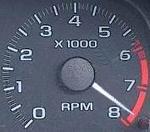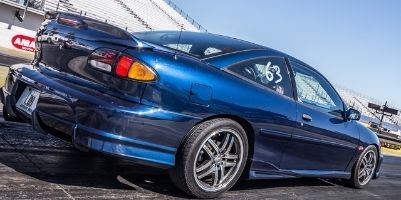Ok, i sort of understand what a tune is but im having slight trouble understanding why exactly do you need one for simple things...please correct me if im wrong about any of this but i read somewhere you'd need a tune for bigger intake manifold and bigger TB, i dont understand why. Wouldn't the sensors take care of adjusting the a/f ratios? i mean we do not have MAFs so i dont see how it would tell there is more air coming in, but it would run lean, the 02 sensor would read its running lean and wouldnt the computer add more fuel to correct that? and wouldnt it be good from there? i mean it wouldnt be perfect but wouldnt it be good enough? same with adding a cam, i understand cams affect rpms and might not run right at low rpms and sound like an old muscle car.
As i was typing this i think im right to an extent, i am guessing the 02 sensors will correct it only so much until it throws a CEL and goes back to stock settings, am i right?
Also as for boosting a car like ours, first off i am not going to do this...but say low boost like 3psi that the injectors/ignition can handle, the only problem without tune would be MAP reading positive pressure? and sensors would take care or everything else if the map wasnt a problem?
huge noob here, please no hate, im really trying to learn...because i was talking to my dad today and he had no idea what a tune was although he's an old school muscle car guy, and there are bunch of turbo civics around here running fine without a tune, im sure they arent getting the most power out if it, but they are running fine...i also see on youtube some turbo cavaliers without tunes, can someone explain how that is possible?
my friend did ebay turbo on his accord and once it hits 1psi, it hits fuel cut...why does that happen to him when others are running fine without tune
again..sorry im a noob with this =/

If I had to guess, I would say that he didn't install a check valve to keep the MAP sensor from seeing boost? As far as running boost without a tune. It's all about the limitations of the computer. It's programmed with a certain set of conditions. It wouldn't know any different if you changed something.
Small example. Lets say the fuel injectors in your car were 10 lb/hr at 50psi of fuel pressure. And you changed to a 20lb/hr fuel injector but changed your fuel pressure to 25psi. In theory, everything is the same, and will work fine because the conditions you've made match what the computer thinks is there. Now say you throw 15psi worth of turbo on doubling your fuel demand. With your bigger injectors, and the 50psi of fuel pressure you have double the fuel going in. So, once again in theory, everything works out to the same and the computer is happy.
You can cheat around the computer a bit. Just takes some knowhow. But it's always better to tune, because that way you can change the variables in the computer, and let it do what it's supposed to do, which is make quick and precise calculations so that you don't have to.
 i find it amusing that SHOoff has nothing better to do but follow me around & be an unhelpful dick in even cross-forum. - Jon Mick
i find it amusing that SHOoff has nothing better to do but follow me around & be an unhelpful dick in even cross-forum. - Jon Mick
As far as needing a tune after the throttle body and intake manifold, it is for the same reason as doing a tune for larger stuff like head and cam work. On our car fueling is determined by two main variables, throttle position and rpm. There is a table that we can edit during tuning and it is called the volumetric efficiency table, one axis is rpm and the other is throttle position. When you step on the gas there would be a certain cell you would be in (maybe 50 percent throttle and 3500 rpms) and that cell would have a percentage value in it. This value is the volumetric efficiency, and without getting into to much detail it is a percentage of the theoretical airflow going into the engine. Now when you add a bigger intake manifold, you are going to be allowing more air to go into the engine at any given throttle position and rpm, but the computer does not know that anything has changed. So you need to tell it that more air is going in by increasing the values in the volumetric efficiency table.
That is a very quick explanation on why you need a tune. However, as you mentioned the oxygen sensors will fix the problem. This is only partially true, because the factory oxygen sensors (on almost all cars) are only used for lower throttle operation like cruise and very mild acceleration. When you floor your car (above 70 percent throttle let's say) your oxygen sensors are ignored and the computer only looks at the values in that table we talked about earlier - but you didn't change them. As a result your car will be running leaner than before at higher throttle positions. This is not such a problem for more basic mods like a cold air intake and maybe even an exhaust, because the computer already runs the car very rich at wot, so it will be leaner but still safe. The intake manifold may run the car too lean without a tune, making it unsafe.
Hope that made sense.
Wagonwes wrote:As far as needing a tune after the throttle body and intake manifold, it is for the same reason as doing a tune for larger stuff like head and cam work. On our car fueling is determined by two main variables, throttle position and rpm. There is a table that we can edit during tuning and it is called the volumetric efficiency table, one axis is rpm and the other is throttle position. When you step on the gas there would be a certain cell you would be in (maybe 50 percent throttle and 3500 rpms) and that cell would have a percentage value in it. This value is the volumetric efficiency, and without getting into to much detail it is a percentage of the theoretical airflow going into the engine. Now when you add a bigger intake manifold, you are going to be allowing more air to go into the engine at any given throttle position and rpm, but the computer does not know that anything has changed. So you need to tell it that more air is going in by increasing the values in the volumetric efficiency table.
That is a very quick explanation on why you need a tune. However, as you mentioned the oxygen sensors will fix the problem. This is only partially true, because the factory oxygen sensors (on almost all cars) are only used for lower throttle operation like cruise and very mild acceleration. When you floor your car (above 70 percent throttle let's say) your oxygen sensors are ignored and the computer only looks at the values in that table we talked about earlier - but you didn't change them. As a result your car will be running leaner than before at higher throttle positions. This is not such a problem for more basic mods like a cold air intake and maybe even an exhaust, because the computer already runs the car very rich at wot, so it will be leaner but still safe. The intake manifold may run the car too lean without a tune, making it unsafe.
Hope that made sense.
Very well said in simple terms. I just want to add yes basic bolt ons might not have to have a tune, but with a tune they can be made better. Also as stated in closed loop operation (normal driving) the O2 sensor is used. The ECU will try to adjust for those changes. These adjustments changes the fuel trims, but it can only do so much. If the fuel trims get too far out of whack and can cause driveablity issues.
 FU Tuning
FU Tuning
i think im slowly undersatnding it..i dont know much about performance lol but so in short the computer's "tuning" ability is limited and getting a real tune will override it and make whatever is new work right?





